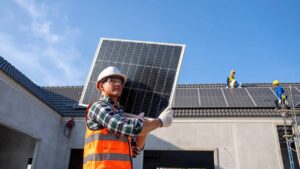Australian solar is charging up investors – and the ASX party is only just getting started

Picture: Getty Images
It’s investing-for-dummies 101: find an undervalued industry that’s set to explode, and get in early.
And why not feel good about where your money is going in the process?
Enter the solar energy sector, one of Australia’s most promising rising industries thanks in part to the geographical particularities of our beautifully expansive sunny nation.
More Australians than ever are riding the green wave and powering their homes with solar energy, according to data from comparison infrastructure tech company CIMET.
Internal figures from CIMET, the business that powers our biggest-name comparison sites like finder.com.au, iSelect, and Cash Rewards, show that searches for solar panels doubled from June 2016 to 2022.
In fact, at least 80% of new housing developments, particularly in Sydney, have solar panels installed.
CIMET also points out that the average Australian could save around $1000 each year by switching to solar, and will even be paid a feed-in tariff for any surplus solar electricity supplied back to the grid.
For that matter, from October 2022 to October 2023, energy connections with feed-in tariffs increased by over 40%.
Yet Australia has tapped less than 5 percent of its potential capacity for rooftop solar – so far.
This presents an astronomical opportunity for solar companies, and the investors that back them.
Australia’s solar industry is set to explode
There are currently over 3 million houses in Australia with rooftop solar, or around 32 percent of eligible dwellings, and yet research shows that residential zones have the greatest untapped potential.
It is predicted that the number of photovoltaic (PV) solar panel systems deployed by households across Australia will increase from 25 million units to over 100 million units by the year 2030.
This is attributed to a perfect storm of favourable factors for the industry.
Government policy designed to help Australia meet its goal of net-zero emissions by 2050 is encouraging the growth of the industry. For instance, the Federal Government’s Renewable Energy Target (RET) policy is designed to ensure that at least 33,000 gigawatt-hours of Australia’s electricity comes from renewable sources by 2020.
Technological advancements in solar panel efficiency and storage capacities are expected to rapidly accelerate the advancement of the industry within the decade.
CIMET also reports that battery prices have taken a beating over the past few years, which is a critical factor to enable complete energy independence for households.
And this will all combine with a rising demand for renewable energy sources that is hardly going to diminish any time soon. As we move towards phasing out coal and gas, Australia’s year-round sunshine practically guarantees that solar will play a leading role in the future energy mix. There is plenty of potential in residential, commercial and utility scale solar farms waiting to be tapped.
So with all fingers pointed firmly in the direction of sustainability, here’s how you can capitalise on the power of the sun.
The up-and-comers
Australia didn’t just invent solar. It is also home to an incredible cohort of startups still leading the way in solar research and innovation, which investors should be following closely.
Take CEFC– and Virescent Ventures-backed startup, SunDrive Solar. SunDrive has fabricated the world’s most efficient commercial-size solar cell by replacing the silver in solar panels with copper, which drives down price and can generate more energy.
Another startup, Sunman Energy, has entirely replaced glass in solar panels with a lightweight, flexible panel. This makes it lighter (by 70 percent!) and thinner (by 95 percent!), and therefore significantly easier to install and transport.
Just as crucially, the Sunman Energy panels can be installed on roofs that are unable to support a conventional solar system, freeing up a lot of previously unusable roof real estate. Think trains like Byron Bay’s first solar train and heritage-listed buildings like the Australian National Maritime Museum.
The ASX-listed solar companies to consider now
There are also a number of publicly-listed companies making waves.
For instance, ClearVue PV (ASX: CPV) produces clear solar glass that can be integrated into building surfaces like glass and building facades.
It has a range of applications including smart windows for buildings, greenhouses, self-powered public utilities and infrastructure, and self-powered building facades. Critically, this opens up untapped commercial opportunities for solar, where solar use is traditionally lower than residential.
Through ClearVue an entire commercial building can be turned into a giant solar panel offsetting the building’s energy usage – an enormously valuable proposition for a property manager looking to save.
Genex Power Renewable Energy (ASX: GNX) also has a growing portfolio of renewable energy solutions, including a 2GW solar project in Queensland, large-scale batteries, pumped storage hydro, and wind.
With a diverse portfolio like this, the energy mix is well integrated and can adapt to the rapidly changing needs of the energy market, offering not just on-demand generation but also storage. The risk tolerance required for investors is also higher due to the diverse mix of technologies.
Tilt Renewables (ASX: TLT), meanwhile, has a number of renewables projects in its portfolio, including solar farms in Broken Hill and Nyngan, and a number of wind farms across Australia.
This also provides a great entry point to the wind energy market. Wind is relatively underdeveloped in Australia, and with a combination of wind and solar, investment and energy generation is diversified.
What to consider when investing in solar
In the solar game, technology is king.
So keep an eye out for emerging panel technologies, as well as value-adds and differentiators that go beyond your average solar panels, offering a competitive advantage over others.
Large investors like the CEFC and Virescent Ventures are also backing big research and commercialisation projects like SunDrive Solar and Sunman Energy, so keep an eye on where the experts’ money is going.
Pay attention to the investment thesis or areas of focus of the big funds, as they may provide clues regarding the solar industry of the future.
Finally, governments around the world are also increasingly creating a mix of private and public funding and incentives pushing for better tech and greater solar adoption.
So watch for major government regulatory changes and macro policy trends, as there will likely be more incentive programs and public-private partnerships that open up new opportunities.
In the end, the writing is on the wall. Many experts are currently expecting the hottest summer on record and increasing energy prices.
So now is the time to be investing in companies that will set the world on fire with renewable energy solutions, and actually slow down global warming.
Jeremy Liddle is the executive director of climate, tech and finance PR agency Third Hemisphere
This article was developed in collaboration with Third Hemisphere, a Stockhead advertiser at the time of publishing.
This article does not constitute financial product advice. You should consider obtaining independent advice before making any financial decisions.
CIMET and Virescent Ventures were clients of Third Hemisphere at the time of writing.
Related Topics
UNLOCK INSIGHTS
Discover the untold stories of emerging ASX stocks.
Daily news and expert analysis, it's free to subscribe.
By proceeding, you confirm you understand that we handle personal information in accordance with our Privacy Policy.








